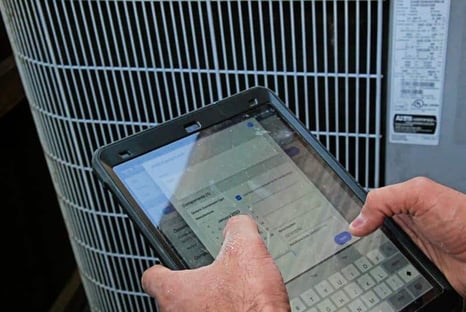What to Ask Before You Buy HVAC Management Software
Admin
Subscribe
The HVAC management software available to field service companies of all sizes is not a new idea. As early as the 1960s and 1970s big service companies began using mainframe computers to get more efficient and provide better customer service.
The pace increased in the 1980s, when personal computers became an affordable business investment – and started the race to see who could email the most spreadsheets around the office.
The 1990s began the move to mobile computing, followed by cloud computing in the 2000s and advanced smart phones in the 2010s.
Technologies change but the reasons we use them are constant. We want greater efficiency in our businesses and better service for our customers.
Today’s HVAC business management software – and all field service management software – is better than ever but there are big differences from company to company. It pays to study carefully before choosing.
Not All HVAC Management Software Is Created Equal
The top five FSM software providers – Oracle, Microsoft, Salesforce, IFS, and ServiceMax – target big business and serve about half of the total global market.
There are dozens of FSM software companies serving the small-to-medium-size contractor market. That number grows every year but most still concentrate on scheduling, dispatching, and other operational functions. That’s all necessary but not sufficient.
 Now, there is an entirely new approach that delivers stronger cash flow and bigger profit margins that result from your increased efficiency. For example, Sera Systems’ field service management software combines built-in business intelligence with your company’s own P&L statement to drive profit margin higher than ever.
Now, there is an entirely new approach that delivers stronger cash flow and bigger profit margins that result from your increased efficiency. For example, Sera Systems’ field service management software combines built-in business intelligence with your company’s own P&L statement to drive profit margin higher than ever.
We wouldn’t claim to know what the best choice is for your business without talking with you, but we do know the questions you should ask to help you make a good choice.
Before we get to that, let’s consider WHY you should be using HVAC management software.
You Cannot Compete Without FSM Software
Competition in retail HVAC services is a lot like Roman gladiators fighting each other to live another day. Only the strong survive. At the beginning of 2023, there were 145,142 HVAC contracting companies in the United States. Of that number, 63% have four or fewer employees.
Upon reaching that size, owners begin to find that business knowledge fast becomes more important than technical skills. A sobering fact from the U.S. Department of Energy is that 70% of new HVAC businesses fail in their first year of operation. Over the first five years, 95% will go out of business.
What about the 5% of companies that survive the five year milestone? Most of them do just that: survive. About 1% become profitable and grow. These are the companies that use HVAC management software to do routine, repetitive work so they can spend more time delivering outstanding service to build a loyal customer base.
To be clear, customer service is the differentiator that builds businesses, not price or equipment brand names. Contractors all sell comparable equipment and systems, regardless of manufacturer. Successful businesses build their brands on delivering exceptional customer service.
“We designed Sera to use my experience to create a virtual, experienced business partner that helps contractors manage what matters so they can achieve that same success.”
"We designed Sera to use my experience to create a virtual, experienced business partner that helps contractors manage what matters so they can achieve that same success."
Billy Stevens, Founder
and CEO Sera Systems
Schedule a 15-minute discovery call
14 HVAC Management Software Questions To Ask
The list of questions is longer than we can discuss here, but here are some of the most important ones.
Q. Should my software be on-premises or in the cloud?
A. A cloud-based Software as a Solution (SaaS) product is almost always best for retail HVAC companies. Big manufacturers with nationwide service departments typically develop custom solutions. They can afford the added up-front expense of buying servers, hiring staff to maintain them and ensure data security. SaaS companies do all that for retail HVAC contractors.
Software updates are more complex with on-premises solutions, so there are more things that can go wrong. With SaaS FMS software you always have the latest version, installed and updated automatically by the software provider. SaaS is more scalable, so you can keep using it without interruption as your business grows to include hundreds of staff.
Q. What types of businesses is the software designed for?
A. The concept of field service management software is the same, regardless of the industry, but there are some differences in the needs of HVAC companies compared to window cleaners, for example. HVAC companies need software with dynamic dispatching to change appointment times on the fly when a job runs long. The same is true for plumbers and electricians, but not so for lawn mowing services.
Q. What features and functionality should I look for?
A. Some features are considered table stakes just to be in the game. Examples include:
- Online scheduling
- Automated dispatching
- Mobile tech app
- Location tracking
- GPS routing
- Mobile data
- Admin portal to track operational performance.
To crack the top 1% of HVAC companies you need HVAC management software that provides a total, integrated business solution. Look for software that:
- Helps you increase cash flow and boost profit margin
- Manages Job Time Efficiency
- Sets up and manages membership plans
- Tech leaderboard that promotes friendly competition
- Secure customer self-service hub
- Price book integration with tech app that calculates good-better-best proposals in minutes.
Sera offers all these, some of them exclusively.
Q. How does the software handle scheduling and dispatching?

A. Most HVAC management software considers scheduling and dispatching as separate but related tasks. The best software treats them as an integrated process.
Customers should have the ability to select the day and time for service appointments and receive a confirmation message immediately. The scheduler should pass appointment information to an automated dispatcher that assigns the right tech for each job based on experience, skills, availability, travel time, and other priorities you can select and change as needed.
Q. What reporting and analytics capabilities does the software offer?
A. Good HVAC management software must help you track key performance indicators with live data anytime, from anywhere. KPIs must be meaningful, including how well techs are performing. This includes quotes accepted and denied, job closing rate, average ticket price, revenue, time sold vs. time used; membership tracking; parts management and ordering; inventory status, and marketing effectiveness. You should be able to track overall company performance and then drill down through each department and see individual tech performance.
Q. Will I need additional staffing to use this software?
A. Not if you have the right software. The whole concept of using field service management software is to automate time-killing processes so you can free up your staff to provide a great customer experience. Many contractors that have switched to Sera have said the complexity of their former software made it hard to learn and use. Some said they added employees to keep up with the demands of the software.
Q. How easy is it to learn and use?
A. FSM software should be so intuitive that everyone can easily learn how to use it and so user-friendly that they will use it. Keep in mind that no company is going to say their software will have your staff scratching their heads or wanting to throw their phones against the wall in frustration. Ask people who use the software about their experience and if they would recommend it.
Q. Is training provided?
A. This is important. No matter how intuitive the software is, it’s natural to feel a little intimidated by the unknown or apprehensive about any kind of change. Initial training should be part of the on-boarding process and continue with a series of video conferences over the next few days. Make certain your account representative/trainer will be available later if you need more help. Most companies provide knowledge centers with streaming videos, explainer documents, and FAQs. The SaaS company should provide continuous training as new features and enhancements are added.
Q. What is the implementation process like?

A. If you choose a SaaS solution, as you should, the HVAC management software is downloaded to your company’s equipment from the vendor’s website by a specialist assigned to your account. The specialist should import your data into the new software. SaaS is a subscription service, similar to other special use software like anti-virus protection and office applications. A small amount of software is installed on your devices to communicate with the SaaS company’s servers.
Q. What security measures are in place?
A. Cloud-based SaaS services are extremely secure. The government uses them for online tax filing and hospitals use them for patient portals. SaaS software companies and their subscribers share the responsibility for security, although the software providers do the heavy lifting.
They provide authentication for secure login, which may include enhanced measures such as another level above password protection. Subscribers must ensure their employees use good security practices. The SaaS company provides encryption for data in storage and Transport Layer Protection for data in transit. Also, ask your SaaS provider if they track your usage so they can quickly spot any unusual activity.
Q. How long does the software take to get up and running?
A. It may require months for some HVAC management software to be fully functional. No matter the provider, there is a long and detailed checklist to follow. However, the more elegant solutions reduce implementation time to a few weeks. For example, most Sera Systems customers are fully functional in 30 days, including installation, data migration, and staff training.
Q. What level of customer support is offered?
A. This is another matter for close scrutiny. As with ease-of-use claims, no company will advertise slow or unresponsive customer support. Ask people who use the software what their experience has been. If you don’t know of any, ask the SaaS company to provide three people for you to contact.
Good customer support is defined by how fast you can get answers and how helpful the answers are. The best SaaS companies provide self-service to help resolve known or routine issues. They have knowledgeable CSRs who can resolve higher-level issues. They go the extra mile, proactively reaching out to customers with helpful user tips and ask how they can serve you better.
Q. What about up-front and ongoing costs?
A. Low up-front cost is a singular advantage SaaS HVAC management software has over on-premises solutions. There is little-to-no equipment cost involved, and you pay as you go, usually on a monthly basis. The amount depends on how many people will be using the software. Find out if pricing depends on data volume and how much you use the service.
Q. What about customization and integration with other systems?
A. Your software should work seamlessly with other applications you use for tasks such as bookkeeping, call tracking, reputation management, CRM, membership programs, payment processing, and marketing. Most SaaS companies have developed integrations with providers of these services. By using those approved providers, you will make software integration a non-issue.
Likewise, good HVAC management software allows you to customize settings to meet your business preferences. For example, Sera’s Dynamic Dispatcher offers a variety of dispatching strategies to prioritize variables such as tech location, availability, experience, and other factors. You also can quickly change pricing throughout the system in minutes.
Conclusion
 Field service management software is a requirement for success in today’s ultra-competitive home services market. That’s because there are more than 145,000 HVAC companies in the US and 20% of them fail every year, only to be replaced by new, hungry competitors with little business experience.
Field service management software is a requirement for success in today’s ultra-competitive home services market. That’s because there are more than 145,000 HVAC companies in the US and 20% of them fail every year, only to be replaced by new, hungry competitors with little business experience.
The US Government says 70% of new HVAC companies fail to last a year in business, and 95% fail in the first five years. Only about 1% of the remaining 5% of companies are profitable – and they use HVAC management software.
Why You Consider Sera for Your FSM Software
Sera field service management software is a total business solution developed to manage small-to-medium-sized field service businesses more efficiently and profitably. Companies that have switched to Sera from other brands have documented 50% higher revenue within six months of using Sera.
Sera was specially designed for HVAC, plumbing, electrical, and garage door companies, and is now becoming available to other types of field service providers.
Sera focuses on what contributes most to profitability – Time Management, Profit Margin, Membership Management, and Cash Flow. It is the first field service management software to be based on each business’s Profit & Loss statement.
Core Components
- Customer Hub – Includes the Online Scheduler, which can be added to any website in minutes so customers can schedule their own appointments. It also includes a secure Customer Portal where customers manage accounts, review service histories, and communicate directly with their contractor.
- Tech App – Simplifies technicians’ lives with wireless job assignments, GPS routing, step-by-step workflows, price books to create multiple Good-Better-Best proposals in less than three minutes, issue invoices, receive payments, and track job time efficiency.
- Admin Portal – Uses live data that provides up-to-the-minute operational and financial performance information of more than 100 key performance indicators; makes technician assignments and automates dispatching to save staff time.
Sera is more than the sum of its parts. It’s the way the core elements work seamlessly together to weave time, membership, margin, and cash flow into every action. Sera is redefining HVAC management software.
See for yourself how Sera can start adding money to your bottom line in the first 30 days.
SCHEDULE YOUR DISCOVERY CALL TODAY to learn more about how Sera’s field service software adds more money to your bottom line.

